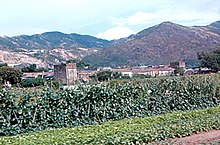Nai Wai
Nai Wai
Chinese: 泥圍 | |
|---|---|
Village | |
 Entrance gate of Nai Wai | |
| Country | People's Republic of China |
| Special administrative region | Hong Kong |
| District | Tuen Mun District |
| Area | Lam Tei |
| Founded by | To (陶) Clan |
| Time zone | UTC+8:00 (HKT) |
Nai Wai (Chinese: 泥圍) aka. Wong Kong Wai (黃崗圍)[1] is a walled village in Lam Tei, Tuen Mun District, Hong Kong.
Administration[edit]
Nai Wai is a recognized village under the New Territories Small House Policy.[2] It is one of the 36 villages represented within the Tuen Mun Rural Committee. For electoral purposes, Nai Wai is part of the Tuen Mun Rural constituency, which is currently represented by Kenneth Cheung Kam-hung.[3][4]
History[edit]



Nai Wai was established by the To (陶) Clan.[5]
Several villages of the Lam Tei area were established by the To (陶) Clan. Originally from Poyang, Jiangxi[6] (other sources mention Watlam in Guangxi),[7] the To Clan moved to Ngau Tam Mei and then to Tuen Mun Tai Tsuen. Following the increase of the clan population, the village dispersed and developed into five villages in the Lam Tei area: Nai Wai, Tsing Chuen Wai, Tuen Tsz Wai, Lam Tei Tsuen and Tuen Mun San Tsuen, which were all fortified.[7]
According to different sources, Nai Wai may have been established around 1368-1398[8] or during the reign of Qianlong Emperor (1735-1796).[1]
Nai Wai appears on the "Map of the San-On District", published in 1866 by Simeone Volonteri.[8]
Features[edit]
Nai Wai was a walled village with four watch towers at the four corners of the square village. The entrance gate was moved to the present southern outer row of houses with its entrance facing south about 200 years ago due to feng shui reasons.[1]
See also[edit]
- Walled villages of Hong Kong, including nearby Sun Fung Wai (adjacent), Tsing Chuen Wai and Tuen Tsz Wai
- Nai Wai stop
- Tuen Mun River
References[edit]
- ^ a b c Antiquities Advisory Board. Historic Building Appraisal. Entrance Gate, Nai Wai
- ^ "List of Recognized Villages under the New Territories Small House Policy" (PDF). Lands Department. September 2009.
- ^ "Recommended District Council Constituency Areas (Tuen Mun District)" (PDF). Electoral Affairs Commission. Retrieved 6 June 2021.
- ^ "Tuen Mun District Council - Tuen Mun DC Members". District Council. Retrieved 12 August 2021.
- ^ Antiquities and Monuments Office: Tsing Chuen Wai - History
- ^ Antiquities and Monuments Office: Tuen Tsz Wai - History
- ^ a b Antiquities and Monuments Office: Historic Building Appraisal. To Ancestral Hall Tuen Tze Wai
- ^ a b Hill, Ronald D. (1985). "Fragments and speculations: the walled villages of Hong Kong". Journal of the Hong Kong Archaeological Society. 11. Hong Kong Archaeological Society: 25–38. OCLC 02465191.
External links[edit]
- Delineation of area of existing village Nai Wai (Tuen Mun) for election of resident representative (2019 to 2022)
- Antiquities and Monuments Office. Hong Kong Traditional Chinese Architectural Information System. Nai Wai
- Antiquities Advisory Board. Picture of the entrance gate
- Antiquities Advisory Board. Historic Building Appraisal. Shrine, Nai Wai Picture
- Pictures of Nai Wai and other villages of Lam Tei
- Cultural Heritage Impact report
